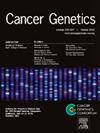Isolated multinodular goiter and follicular adenoma associated with a novel germline DICER1 variant: A benign presentation
IF 2.1
4区 医学
Q4 GENETICS & HEREDITY
引用次数: 0
Abstract
DICER1 syndrome is a tumor-predisposition disorder caused by a germline pathogenic variant in DICER1. Pathogenic variants of DICER1 are the monogenic cause of various tumors including pleuropulmonary blastoma (PPB), ovarian sex cord-stromal tumors, and multinodular goiters. We present a family with a novel DICER1 pathogenic variant c.5528–2del who presents with development of isolated thyroid goiters/follicular adenoma. A 44 year old female presents with a past medical history of total thyroidectomy along with her 14-year-old son with a past history of multinodular thyroid goiter confirmed as multifocal follicular adenoma with papillary architecture and her 12-year-old daughter with a past history of multinodular thyroid goiter confirmed as diffuse nodular thyroid hyperplasia. No additional DICER1 syndrome presentations were observed. A genetics panel revealed that the mother, the 14-year-old son, and the 12-year-old daughter share a heterozygous DICER1 c.5528–2del variant, which has not been previously reported. In addition to our direct clinical observations from this family, genetic analysis via in silico prediction models, segregation analysis, and ACMG classification support this variant to be pathogenic. Given the absence of other DICER1 syndrome manifestations through human genetics evidence, this variant may be specifically associated with isolated multinodular goiters/follicular adenoma. Our findings contribute to the expanding genotype-phenotype correlation in DICER1 syndrome, providing new insights into its variable clinical presentation. Since not all variants are identical, reporting of these observations will advance precision medicine and benefit future patients through more accurate diagnosis, prognosis and personalized management strategies.
分离的多结节性甲状腺肿和滤泡性腺瘤与一种新的种系DICER1变异相关:一种良性表现
DICER1综合征是一种由DICER1种系致病性变异引起的肿瘤易感性疾病。DICER1的致病变异是多种肿瘤的单基因病因,包括胸膜肺母细胞瘤(PPB)、卵巢性索间质肿瘤和多结节性甲状腺肿。我们报告了一个具有新型DICER1致病变异c.5528-2del的家庭,该家庭表现为孤立性甲状腺肿/滤泡腺瘤的发展。一名44岁女性,既往有甲状腺全切除术病史,她14岁的儿子既往有多结节性甲状腺肿病史,证实为多灶性滤泡腺瘤伴乳头状结构,她12岁的女儿既往有多结节性甲状腺肿病史,证实为弥漫性结节性甲状腺增生。没有观察到额外的DICER1综合征。遗传学小组发现,母亲、14岁的儿子和12岁的女儿共有一种杂合的DICER1 c.5528-2del变异,这在以前没有报道过。除了我们对该家族的直接临床观察外,通过计算机预测模型、分离分析和ACMG分类进行的遗传分析也支持该变异具有致病性。鉴于通过人类遗传学证据缺乏其他DICER1综合征表现,该变异可能与孤立性多结节性甲状腺肿/滤泡性腺瘤特异性相关。我们的发现有助于扩大DICER1综合征的基因型-表型相关性,为其可变的临床表现提供新的见解。由于并非所有的变异都是相同的,报告这些观察结果将推进精准医疗,并通过更准确的诊断、预后和个性化的管理策略使未来的患者受益。
本文章由计算机程序翻译,如有差异,请以英文原文为准。
求助全文
约1分钟内获得全文
求助全文
来源期刊

Cancer Genetics
ONCOLOGY-GENETICS & HEREDITY
CiteScore
3.20
自引率
5.30%
发文量
167
审稿时长
27 days
期刊介绍:
The aim of Cancer Genetics is to publish high quality scientific papers on the cellular, genetic and molecular aspects of cancer, including cancer predisposition and clinical diagnostic applications. Specific areas of interest include descriptions of new chromosomal, molecular or epigenetic alterations in benign and malignant diseases; novel laboratory approaches for identification and characterization of chromosomal rearrangements or genomic alterations in cancer cells; correlation of genetic changes with pathology and clinical presentation; and the molecular genetics of cancer predisposition. To reach a basic science and clinical multidisciplinary audience, we welcome original full-length articles, reviews, meeting summaries, brief reports, and letters to the editor.
 求助内容:
求助内容: 应助结果提醒方式:
应助结果提醒方式:


